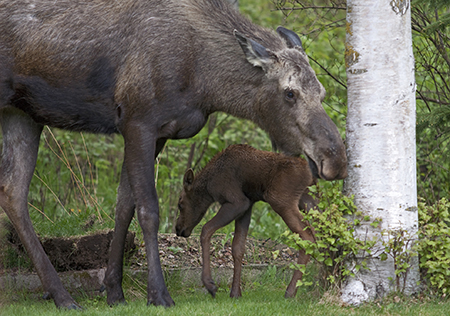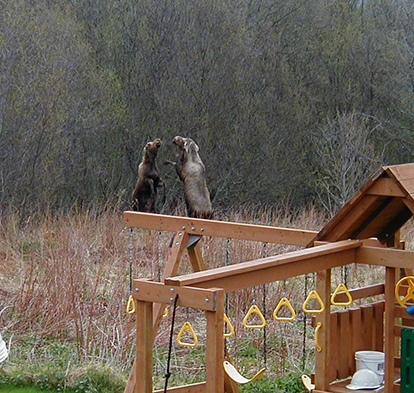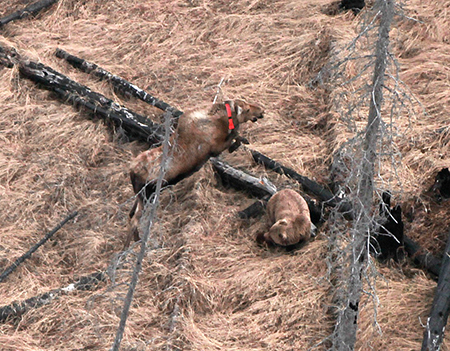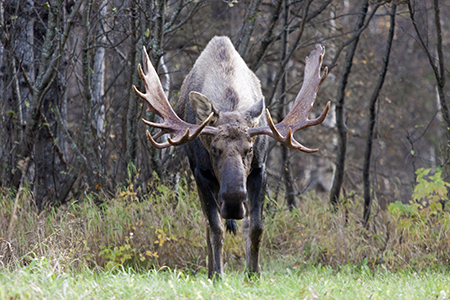Alaska Fish & Wildlife News
January 2020
Kicking and Stomping
Moose Hooves are a Formidable Defense

Moose are not usually aggressive but they can be dangerous under certain circumstances. More people are injured in Alaska by moose than by bears.
Unlike bears, moose don’t bite. They kick. In a moose’s world, where bears and wolves want to eat you and are especially eager to eat your babies, kicking and stomping can be a formidable defense. Sometimes people wind up on the wrong end of those hooves, usually belonging to a defensive mother moose.
In late May of 2019, a man walking his dog in an Eagle River neighborhood was attacked when he inadvertently got between a cow moose and her calf. A few weeks later, a man in Colorado suffered a similar fate in a similar situation.
In winter, moose can be aggressive when harassed by people, dogs and traffic, and are more likely to be hungry, tired and frustrated with deep snow. In January of 1995 a 71-year-old man was killed on the University of Alaska Anchorage campus by an aggressive moose.
Predators are injured and killed by moose, and biologists offered a look into the power of the moose’s best defense.
The 360 kick and moose boxing
Wildlife biologist John Crouse is a moose researcher and serves as director of the Kenai Moose Research Center. He’s worked with captive and relatively tame moose, and wild moose, for decades and seen a wide variety of moose behavior, including their interactions with each other and with people. He said moose are agile and can kick in all directions.
“They generally kick with their front legs,” he said. “That’s most common, but it depends. Sometimes they get annoyed and they’ll kick back. If they feel threatened, they can kill you with a hind leg kick.”
When a moose delivers a hard, fast kick with its hind leg, Crouse said you can hear the tendons and ligaments pop and snap when the hoof comes back at the end of the kick. They can kick straight ahead and will also rear up and stomp.
“The front leg will come straight up with that hoof, they’ll also come forward and kick out at the side, and they can come down as well, on to the top of your head or shoulder,” he said. “From what I’ve observed they can pretty much kick 360 degrees around them.”
It’s common for moose to kick each other. There is a hierarchy in a group, and that order might be stable for a period, but Crouse said it’s dynamic. It changes with the season, their mood, and whether a cow has a calf. Outside the breeding period conflicts are mostly associated with food, he said.
“They’re browsing and one moose wants a particular shrub. Often, they have it sorted out, you’ll see their ears lowered and other forms of communication, but if they don’t have it worked out, they’ll be kicking, or standing up on their hind legs and boxing each other. They’ll do that occasionally to us, rear up on their hind legs. Instead of being six or seven feet tall at the shoulders, they’re nine feet in the air, and their legs are above your shoulder. Their head is well above you; and the hooves are above your head.”
He said bull moose spar with their antlers when they have them, but when they’ve dropped their antlers they’ll rear up and box like the cows.

Moose get frustrated and Crouse described what he called moose tantrums.
“They’ll get so upset about something sometimes they have to blow off that energy,” he said. “They’ll run around in circles, their hair is all erected and up straight; they will run with their legs jerking out and kicking sideways.”
Wildlife biologist Layne Adams noted that moose are good at kicking on the run. “Elk will do that too, it’s amazing how they can lash out with a hoof while running at a pretty good clip,” he said.
Moose and predators
Layne Adams worked with moose and wolves in Denali, and spent decades studying caribou. He’s with the USGS in Anchorage at the Alaska Science Center. He said biologists who work with wolves often see healed injuries of one kind or another, particularly to wolves living in areas where they hunt moose rather than caribou or deer.
“We picked up animals over the years that had broken legs, and I suspect some or most of those came from altercations with moose,” he said. “I wouldn’t say they’re common, but it’s not surprising to see them. Wolves are tough animals, they deal with a lot of abuse and are able to get those healed up and continue to live.”
He cleaned wolf skulls over the years, boiling, scraping and picking out all the meat. One skull displayed evidence of a remarkable healed injury.
“When I was done you could see that about one-quarter to one-third of the brain case was pushed in, and it pretty much followed the shape of the side of the hoof of a moose,” he said. “It was pretty easy to picture that wolf had been kicked in the head, and it had healed.”
He picked up a dead wolf in Denali that was almost certainly moose killed, he said. “The ribs were kicked in, smashed in, and from where it was lying it didn’t look like it had fallen off a cliff or anything like that.”
He added that John Blake at UAF performed a necropsy and determined it died from blunt force trauma to one side of its ribcage.
One incident stood out. He and a colleague were in a helicopter tracking a collared female wolf. As the pilot brought them in, they saw the female and her mate standing beside a river. They darted the male and as they were putting on a radio collar, they saw a moose standing off in the bushes and realized what was happening.
“They had bloodied him up pretty good,” he said. “The wolf had been limping and had blood on his fur. We put it together - he and his mate were in the process of trying to kill this moose. The wolf’s hind leg was broken.”
They collared the injured wolf and left and checked back the next day.
“They were eating that moose,” he said. “I suspect the mate was instrumental in bringing down that moose.
That male was killed a few months later by another wolf, or wolves, and since he was collared, they were able to locate and retrieved him. When Adams examined that broken leg, he said it was healed.
“It was like it was splinted with ossification,” he said. “Bony material that forms in and among the muscle tissue around the break, layers of it. We’ve caught other wolves that had broken legs healed like that.”

Retired Fish and Game biologist Rod Boertje saw similar injuries in his long career in Interior Alaska working with moose, wolves and bears. In the course of a project where radio-collared wolves were tracked to evaluate the cause of death he said a couple were killed by moose.
He wrote: “Broken and healed ribs and fractured and healed skulls were not uncommon among wolf carcasses I examined from the Fortymile country, where moose are a predominant prey. Pretty uncommon for wolves to die from a moose kick but I do recall 2 of 23 translocated wolves (Fortymile wolf translocation project) that died in the first year after translocation were killed by moose.”
Patrick Endres related a first-hand account of a battle between a moose and a group of wolves. Endres is a Fairbanks-based professional wildlife photographer and author. In June of 2010 he was working in Denali National Park and photographed a heated fight between a mother cow moose and members of the Grant Creek wolf pack who were trying to grab her young calf.
The battle occurred in a small, shallow pond, surrounded by a willow thicket. Endres said the cow and calf moved out of the willows to the pond right before the wolves showed up.
“I think she sensed the wolves appearing,” he said. “They didn’t come at once as a large pack, and eventually there was a total of five. The pond was the only area free of obstructions, and I suspect she went there for visibility and mobility.”
The cow charged and kicked at the wolves, mostly using her front feet, but also with her back legs. The wolves were never really after her, they wanted the calf, he said. The calf stayed close, often taking protection under the cow herself, and he thinks she might’ve stepped on the calf at some point, but it was hard to tell as there was so much movement and action.
There was a tremendous amount of water flying, he said. “She was stomping a lot, not really rearing up like a horse, but stomping with her front feet. She was really ferocious; it would’ve been fatal if she’d connected.”
He said he did not see her connect with a solid kick, and he didn’t see any wolves limping or acting like they’d been kicked or stepped on. There was some contact, but nothing serious.
“They are extremely cunning, those wolves,” he said. “To see their agility and the strategic way they moved in and out. One would move in and get her attention, then the others would come in from the back or the sides. It was amazingly orchestrated.”
After about 10 minutes both the cow and the calf became visibly weakened and fatigued, and he said eventually a couple of wolves grabbed it. “The cow was exhausted, and there seemed to be a sense of resignation that she lost, but it’s hard to know what an animal is thinking.”
Endres is likely correct, as there is a pragmatic biological element to the cow’s resignation. Biologist Rod Boertje also saw predators take moose calves from defensive mother moose.
“There were a couple instances where the cow defended too long and ended up in the burial pile along with twin calves,” he wrote in an email. “Must be hard for evolution to fine tune how aggressive to be when defending offspring.”

He described an incident from the mid-1980s that stood out, where a cow lived to fight another day. He was tracking a radio-collared grizzly bear from a small plane and caught up to a male bear (a boar) that was on a scent. He wrote:
“A boar I was radiotracking was on a gallop with its nose to the ground, blood-hound style. Up ahead about a 1/2 mile I could see a cow and calf (maybe 2 weeks old) moving away through the scattered spruce at a relatively slow pace. The cow turned and faced the bear with the calf behind the cow a few yards. The boar didn't hesitate to come right at the cow. On his first approach, the cow boxed and sent the boar in a somersault backwards. The boar didn't seem too fazed and hardly hesitated to approach again head on with a similar response. On the third approach the boar reached around the cow's head and scraped out a noticeable amount of hair from the cow's left shoulder and she immediately retreated to her right. The boar was on the calf immediately thereafter.
That boar was at least 300 pounds maybe 350, not huge but larger than the sows I had collared. The amount of balance and agility it must take for a roughly 1,000-pound cow to do that to a running 300+ pound plus grizzly is almost unimaginable.”
It is also incredibly effective. If a moose can make it to two years of age, mortality from predation by bears and wolves is quite low. Boertje and his colleagues Graham Frye and Don Young studied moose mortality in the Central Tanana Flats area of Interior Alaska and published the results in the January 2020 issue of the Journal of Wildlife Management. Wolves kill a significant number of moose calves, and are increasingly able to kill moose as they grow beyond about eight years old, but an adult moose in its prime is a formidable adversary for a predator.
Riley Woodford is the editor of Alaska Fish and Wildlife News and produces the Sounds Wild! radio program.
What to do if you find a baby animal
Lifetime Sex-Specific Moose Mortality During an Intentional Population Reduction: Journal of Wildlife Management January 2020
Safety around aggressive moose
The Grant Creek wolf/mother moose encounter
Video – Staying safe around moose: A 12-minute video on safety around urban moose, produced by ADF&G and middle school students at Mirror Lake School. Target audience is third-fifth graders.
Subscribe to be notified about new issues
Receive a monthly notice about new issues and articles.
